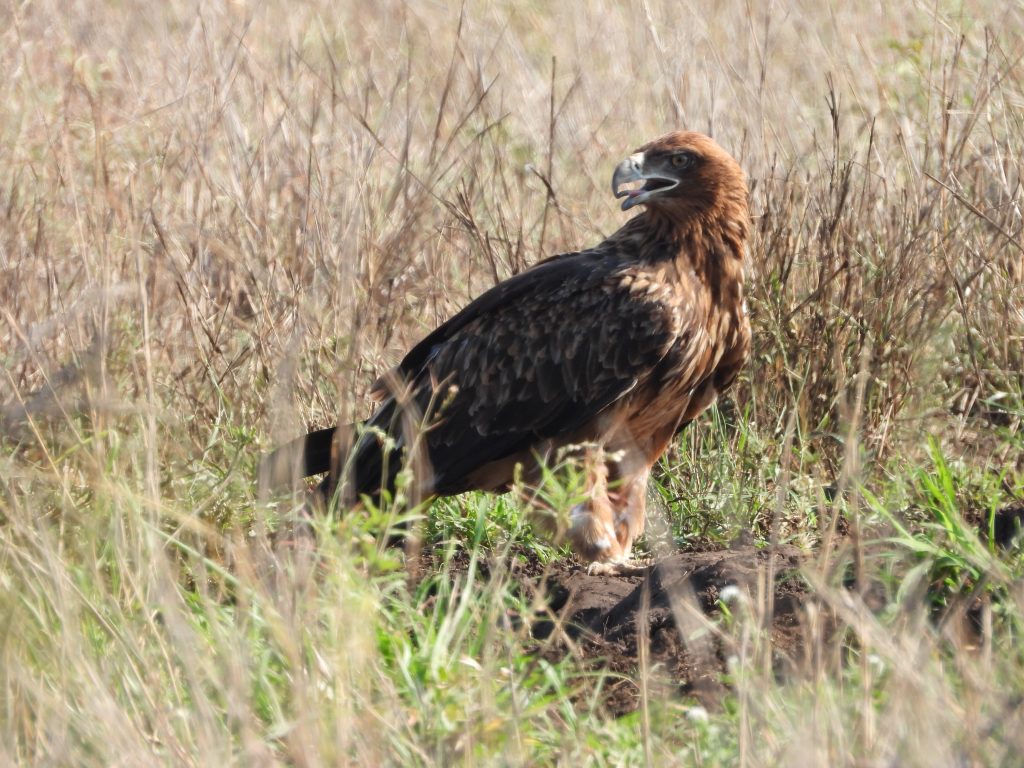When you think of African wildlife, iconic animals like lions or elephants often come to mind. But for safari-goers, the Tawny Eagle (Aquila rapax) is a fascinating bird of prey that embodies the raw intelligence and adaptability of Africa’s ecosystems. Often compared to hyenas for their scavenging habits, Tawny Eagles are far more than opportunistic thieves—they are skilled hunters and a thrilling sight on an African safari. In this blog, we’ll explore the Tawny Eagle’s distribution, appearance, hunting strategies, and breeding behaviors, making it a must-see species for your next adventure with Wandering Thru.
Distribution and Habitat of Tawny Eagles
Tawny Eagles are among Africa’s most widespread eagles, thriving in diverse habitats except dense forests and true deserts. From savannas to woodlands, they excel in protected areas like Serengeti National Park, Kruger National Park, or Maasai Mara, making them a thrilling sight on an African safari. However, human expansion has made these conservation areas vital for their survival.

Visitors from the Northern Hemisphere might mistake Tawny Eagles for Golden Eagles, though Tawny Eagles are slightly smaller. In Africa, they can be confused with Wahlberg’s, Steppe, or Lesser and Greater Spotted Eagles due to their varied color morphs. Adult Tawny Eagles range from pale yellow to dark chocolate, with some heavily streaked and others nearly unmarked. Their honey-brown eyes and distinct facial expressions help set them apart. Juvenile Tawny Eagles are often more striking, sporting straw-yellow to pale rufous plumage with darker, almost black eyes.
Hunting and feeding
Like hyenas, Tawny Eagles aren’t picky about their protein or how they get it. They’ll eat anything from termites to elephant carcasses, showcasing their versatility. As kleptoparasites, they expertly steal kills from smaller birds like falcons or even Southern Ground Hornbills. At carcasses, they’re often the first to arrive alongside Bateleurs and Hooded Vultures, but larger vulture flocks can push them to the fringes. Still, their cheeky nature lets them dart in for a quick morsel.

Despite their scavenging reputation, Tawny Eagles are skilled hunters. While their talons aren’t as powerful as larger eagles, they take down game birds like spur-fowl and guineafowl, as well as young monkeys, impala lambs, and even wild dog or jackal pups. With keen eyesight, they hunt from perches or in flight, seizing opportunities with precision
Breeding and nests
Tawny Eagles are monogamous, fiercely defending their territories with their lifelong mates. Their nests, built high in tree crowns for easy access, are reused for years if undisturbed. Breeding occurs in autumn to avoid scorching summer heat, with eggs incubating for 39–44 days. Typically, two eggs are laid, but the stronger chick often outcompetes its sibling, ensuring only one survives—a natural backup plan.

Chicks remain in the nest for 10–12 weeks before fledging, relying on both parents for food. After their first flight, juveniles depend on their parents for another two months and may stay in the territory for a season. However, when the next breeding cycle begins, parents chase them out to fend for themselves.
Why Tawny Eagles Are a Safari Must-See
Tawny Eagles, often labeled as mere scavengers, deserve more credit for their intelligence and adaptability. Like hyenas, they’re aggressive opportunists, thriving across Africa’s diverse landscapes. Their bold behavior and striking presence make them a standout on any safari. Whether you’re a birdwatching enthusiast or eager to explore Africa’s wildlife, spotting a Tawny Eagle is an unforgettable experience.
Share this:
- Click to share on Facebook (Opens in new window) Facebook
- Click to share on X (Opens in new window) X
- Click to share on WhatsApp (Opens in new window) WhatsApp
- Click to share on Threads (Opens in new window) Threads
- Click to share on Reddit (Opens in new window) Reddit
- Click to email a link to a friend (Opens in new window) Email





